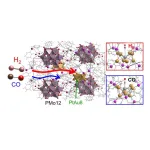(Press-News.org) The report “Assessing Deep-Tech Innovation Hubs in Germany: The Case of Biotechnology” evaluates Germany’s performance in deep-tech innovation within biotech using a comprehensive index and examines five key hubs: Berlin, Heidelberg, Munich, Nuremberg-Erlangen, and Stuttgart. These hubs were analyzed in terms of fundamental research, research and development in biotech, startup activity, public infrastructure, and business environment.
Berlin, Munich, and Heidelberg are the leading biotech hubs
Berlin leads the index due to its strong public infrastructure and extensive clinical research. Munich follows in second place, excelling in startup support and late-stage financing. Heidelberg ranks third, distinguished by its strength in fundamental research. Nuremberg-Erlangen benefits from a specialized ecosystem in medical technology, while Stuttgart boasts a highly diversified economic structure with strong potential for interdisciplinary innovation.
“Biotech is essential for addressing challenges in healthcare and climate protection and has the potential to drive groundbreaking breakthroughs,” explains Francis de Véricourt, professor of management sciences, Joachim Faber Chair in Business and Technology, and academic director of the DEEP Institute at ESMT. “For the first time, our index provides a structured evaluation of Germany’s biotech hubs across the entire value chain.” The study covers an eight-year period.
“Despite their unique strengths, most leading biotech hubs have seen a decline in their ability to transform research into market-ready solutions over the past decade. Apart from Munich, all top hubs have lost efficiency, despite a temporary boost during the COVID-19 pandemic,” explains Daniel Posch, innovation expert at Bertelsmann Stiftung.
Germany’s biotech sector falls short of its potential
Germany has strong conditions for biotech innovation, including world-class fundamental research in several future-oriented fields, a robust industrial base in the chemical and pharmaceutical industries, and a steady influx of international science, technology, engineering, and mathematics (STEM) students. However, the country is not fully capitalizing on its research strengths, leaving significant economic potential untapped. This is mainly due to a weaker knowledge transfer into market-ready applications compared to international peers.
“Germany’s innovation potential is essentially lost in translation,” says Posch. Technology transfer in deep tech is inherently challenging due to high technological and economic risks. Moreover, the comparatively high fragmentation of Germany’s biotech landscape creates additional hurdles.
To enhance innovation dynamics in the domestic biotech sector, de Véricourt sees potential in targeted collaboration among Germany’s leading hubs: “Our research shows that German biotech hubs have different but often complementary strengths. Expanding and better connecting these key domestic hubs could transform them into an integrated ecosystem.”
In addition to fostering collaboration and networking—also on a European level—resources should be strategically allocated to support a select few, particularly promising German hubs. This approach could help achieve a critical mass of research and entrepreneurship in the medium term. Posch adds, “Future policy initiatives in this sector should prioritize excellence over broad-based funding.”
END
Biotech in Germany has significant potential, but lack of collaboration hampers growth
2025-02-10
ELSE PRESS RELEASES FROM THIS DATE:
Does pain affect cancer survivors’ use of non-opioid substances?
2025-02-10
Experiencing pain may increase the odds that cancer survivors will use cigarettes and cannabis, according to a recent study published by Wiley online in CANCER, a peer-reviewed journal of the American Cancer Society. The study also found that cigarette smoking and pain are linked to more treatment-related side effects and worse health among cancer survivors.
Pain and use of cigarettes, e-cigarettes, alcohol, and cannabis commonly occur together in the general population. To characterize pain in relation to such non-opioid substance ...
Scientists find that a playful approach to life activates ‘lemonading’, which helps people cope with adversity
2025-02-10
Scientists have found that taking a playful approach to life doesn’t mean you don’t take your situation seriously, but it can mean you cope with it better. By surveying people about their experiences during a Covid-19 lockdown, they learned that more playful people were more positive about the future and coped more actively and creatively. Life gave them lemons, and they made lemonade.
“Our study revealed that playfulness and resilience are intimately connected through what we call ‘lemonading’ — the ability to imagine ...
Candidate genes in canine hepatocellular carcinoma for molecular targeted therapy
2025-02-10
Unresectable canine hepatocellular carcinoma (HCC) has limited nonsurgical treatment options. Sorafenib is a targeted therapy for unresectable canine HCC. However, there are limited reports on the expression of target genes. Therefore, the efficacy of the targeted therapies for canine HCC remains unclear.
In HCC, the prognosis is generally good when complete surgical resection is possible. Unresectable nodular and diffuse HCC have a poor prognosis and limited nonsurgical treatment options. In humans, systemic therapies including ...
Opioid prescriptions in the ED linked to small increases in future opioid use, hospitalizations
2025-02-10
Opioid prescriptions in the emergency department (ED) were associated with small increases in later opioid prescriptions and hospital admissions, found new research published in CMAJ (Canadian Medical Association Journal) https://www.cmaj.ca/lookup/doi/10.1503/cmaj.241542.
To understand the relationship between opioid prescribing in the ED and subsequent harm, researchers looked at opioid prescribing at all Alberta EDs from 2010 to 2020. Of the more than 13 million visits, 689 074 patients (5.3%) filled an opioid prescription. The researchers found that opioid prescriptions did not increase the risk of ...
During pandemic, playful people were remarkably resilient, OSU research shows
2025-02-10
CORVALLIS, Ore. – Adults with high levels of playfulness showed strong resilience during the COVID-19 pandemic compared to less playful individuals, new research shows.
The study led by Xiangyou “Sharon” Shen of Oregon State University is important because playfulness is a vital but underappreciated resource for building resilience and maintaining well-being during difficult periods such as the pandemic, Shen said. And it’s a resource that individuals can cultivate.
“Understanding how playful people navigate adversity can inform interventions and strategies to help people cope with stress and uncertainty,” said Shen, an assistant professor ...
Tracing gas adsorption on “crowns” of platinum and gold connected by nanotunnels
2025-02-08
Tokyo, Japan – Researchers from Tokyo Metropolitan University have elucidated how hydrogen and carbon monoxide is adsorbed into solids containing a crown-motif structure of platinum and gold. Using quick-scan X-ray absorption measurements and theoretical calculations, they studied a solid of [PtAu8(PPh3)8]-H[PMo12O40] called PtAu8-PMo12 and found that gas adsorption is affected strongly by the dimension of nanoscale voids in the structure. This highlights the importance of engineering voids in materials for next generation sensors and gas separation.
Ligand-protected metal clusters have been a source of ...
Rare bird skull from the age of dinosaurs helps illuminate avian evolution
2025-02-08
A new study in Nature describing a fossil of a nearly complete and intact bird skull from Antarctica is shedding light on the early evolution of today’s birds and avian diversity at the end of the Age of Dinosaurs.
The skull is from Vegavis iaai, an extinct duck-like bird that lived during the Late Cretaceous, just before non-avian dinosaurs went extinct. It’s one of very few 3D bird skulls known to science from the Cretaceous — a 79-million-year geological period and the last era when ...
Researchers find high levels of the industrial chemical BTMPS in fentanyl
2025-02-08
A UCLA research team has found that drugs being sold as fentanyl contain high amounts of the industrial chemical bis(2,2,6,6-tetramethyl-4-piperidyl) sebacate, or BTMPS. This new substance of concern emerged in the illicit drug supply nearly simultaneously in multiple U.S. locations from coast-to-coast.
From June through October 2024, the team quantitatively tested samples of drugs sold as fentanyl that had high levels of the chemical, which belongs to a class of compounds called hindered amine light stabilizers ...
Decoding fat tissue
2025-02-08
As many as 40% of Americans are obese, putting them at an increased risk for high blood pressure, diabetes, stroke, heart disease and certain cancers, according to the CDC. New research from the University of Delaware aims to tackle the issue by investigating obesity at the gene level.
Principal investigator Ibra Fancher, assistant professor of kinesiology and applied physiology in UD’s College of Health Sciences, discovered significant differences in gene expression in adipose tissue, more commonly known as fat. Formerly considered fat storage, adipose tissue is now recognized as a vital ...
Solar and electric-powered homes feel the effects of blackouts differently, according to new research from Stevens
2025-02-08
Hoboken, N.J., February 7, 2025 — As winter storms and summer heat waves increasingly stress the nation’s power grids, Stevens researchers have developed a new way to identify the homes most vulnerable to blackouts — without even visiting them.
The timing couldn't be more critical. With more than a quarter of U.S. homes already fully electric, and solar installations set to triple during the next five years, understanding vulnerabilities has become critical for emergency planning and public safety.
"We're ...



